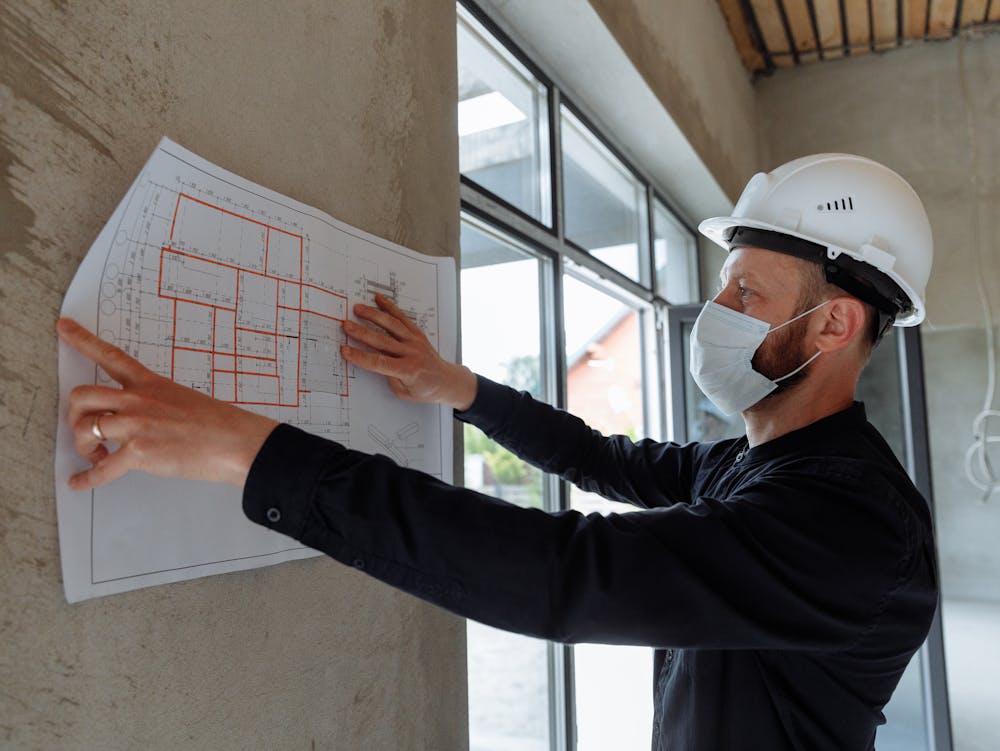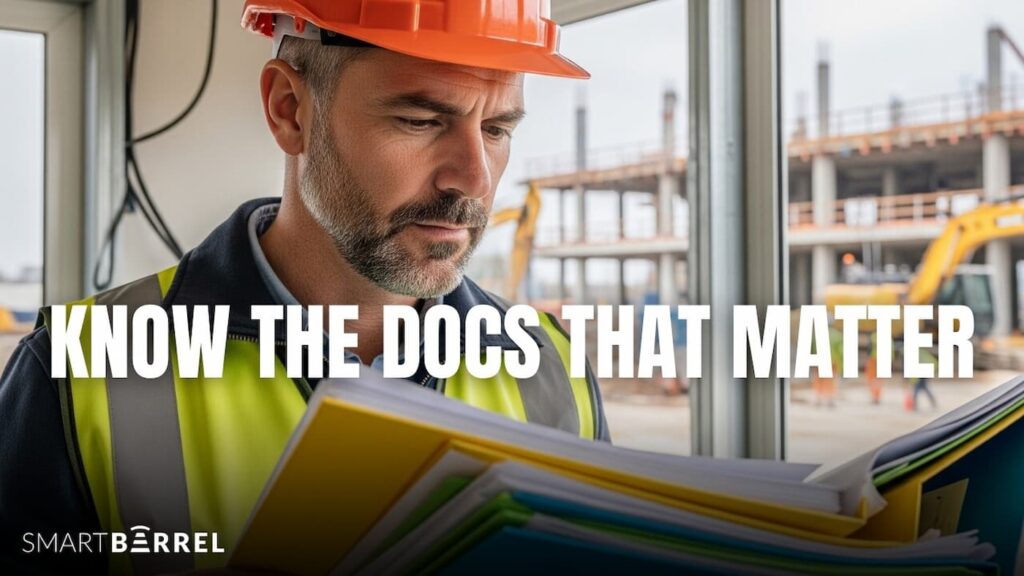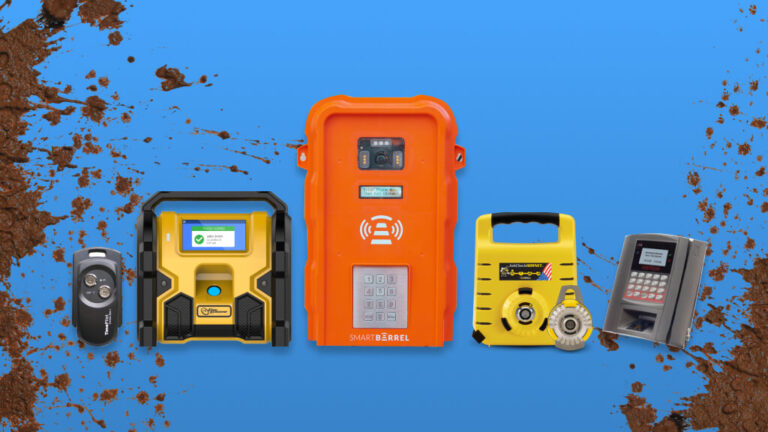Construction teams rely on documentation to move work forward, such as RFIs, schedules, logs, and contracts.
When even one file is outdated or missing, delays turn into disputes, and accountability falls on supers and PMs.
The issue isn’t effort…it’s disconnected systems.
Most crews still juggle important files all over inboxes, binders, and static folders. Since there’s no single source of truth, it can be hard to find what you need when you need it. Every project needs a clear, jobsite-ready approach to documentation in order to be successful.
This guide breaks down the core construction documents every superintendent and PM must control to stay audit-ready, avoid disputes, and keep projects on track from precon to closeout.
What Are Construction Documents?
Construction documents are the official records that guide and verify every phase of a project. They go far beyond just blueprints.
These documents include contracts, specifications, schedules, RFIs, payment applications, drawings, daily logs, safety logs, and more.
When organized well, they create a single source of truth for project managers, supers, owners, and field teams.
In the construction world, decisions happen fast. Without clear documentation, even minor miscommunications can hinder progress or lead to disputes.
That’s why understanding what construction documents are and how they interconnect is essential for staying on schedule and out of trouble
Get Control of Your Time Tracking
6 Essential Construction Documents Every PM and Superintendent Needs

Every phase of a construction project hinges on having the right documents at the right time.
Miss one, and the consequences ripple through subs, owners, finance, and inspections.
Below are the essential document categories project managers and superintendents need to track with precision.
1. Project Initiation & Planning Documents
Before any work starts, teams rely on core planning documents that define the scope, budget, and responsibilities. If these documents are weak or missing, teams waste time chasing approvals, working off assumptions, or misaligning on scope before the job even starts.
That leads to blown budgets and scope creep right out of the gate.
These define the “what,” “why,” and “who” of the project.
Project Charter:
Outlines the project’s goals, constraints, and key stakeholders. It acts as the official green light to begin planning.
Feasibility Study:
Calculates cost, timing, and risks to confirm the project is viable before teams mobilize.
Stakeholder Matrix:
Maps out who’s involved, their influence, and their responsibilities. Prevents scope creep and miscommunication from day one.
Pro Tip: Sync these docs with the master schedule early to prevent scope clashes between jobsite ops and office finance teams.
2. Design & Specification Documents
Design documents explain how a project needs to be built, with what materials, and to what standard.
Confusion over specs or outdated drawings can stall inspections or lead to noncompliant installations, especially in regulated environments like hospitals or public buildings.
For PMs and supers, these files form the execution blueprint and must be understood beyond surface-level visuals.
They include:
Construction Drawings
Mostly related to site plans, elevations, structural layouts, and MEP schematics.
Technical Specifications
As drawings show dimensions and layouts, specs define quality.
These documents clarify performance standards. For instance, while a drawing might show a wall section, the spec will dictate fire rating, insulation type, and approved products.
As-Built Drawings
As-built documents get updated during construction to reflect field changes, adjustments, or reroutes.
They’re required for inspections, change orders, and closeout, especially in systems-heavy builds like hospitals or data centers.
Pro Tip: Store all updated drawings in one centralized system and confirm version numbers in every foreman huddle. Miscommunication on a revised plan is one of the top causes of field delays.
3. Legal & Contractual Documents
When things go sideways, like delayed payments, disputes, or scope changes, these are the first documents that get pulled. If they’re incomplete or outdated, the company loses leverage fast.
Project managers and supers must know which document governs what, and when it needs to be produced.
Contracts & Subcontracts:
These define the project’s terms: scope, payment terms, penalties, and responsibilities.
Subcontracts add detail for each trade’s deliverables. Any gaps here create risk, especially when change orders hit or delays occur.
Change Orders
Change orders formalize adjustments in scope, cost, or timeline.
Without signed approval, teams risk doing unpaid work. Supers should never execute a change without a documented, dated order.
Insurance Certificates & Bonding
These provide financial backing and workforce protection.
Project managers must track expirations and ensure trades are covered, especially before mobilization or major work phases.
Lien Waivers
Issued during payment cycles, lien waivers protect against double payment or payment disputes down the line.
Missing or outdated lien documents are one of the top reasons for the delayed release of funds from owners or lenders.
4. Financial & Administrative Documents
Errors in SOVs or payment apps delay billing. Missed payroll reports or tracking gaps can lead to noncompliance and strained subcontractor relationships.
Every project manager and superintendent needs to master the following financial and administrative documents that keep the money moving and the paper trail clean.
Schedule of Values (SOV)
The SOV is the billing roadmap. Each line item represents a measurable piece of work tied to a dollar amount.
When built properly, it aligns with the scope and work progress.
Pro Tip: Match SOV line items to field-tracked activities, especially labor hours, to make approval smoother during billing cycles.
Payment Applications
These formal requests for payment draw directly from the SOV.
Each pay app includes % complete per item, previous payments, and retainage. Errors or vague entries here are one of the biggest reasons owners delay release.
Certified Payroll Reports
On public projects, these are non-negotiable.
Certified payroll confirms that workers are paid the correct prevailing wage and includes detailed job classifications, hours, and rates.
Budget Tracking and Cost Reports
These internal docs help PMs track actual spend vs. projected budget. Smart supers review them weekly to detect cost overruns early, not after it’s too late to course correct.
5. Jobsite & Field Management Documents
Even the best contract or design is worthless if the daily jobsite isn’t documented accurately.
When inspectors show up, when disputes arise, or when payments stall, these are the records that protect PMs and supers.
SmartBarrel backs this up with verified daily data straight from the field. It captures labor hours, absentee reports, and daily crew activity with facial verification, timestamps, and cost code matching, giving PMs real-time proof when it matters.
Here are the core construction documents SmartBarrel helps support at the jobsite level:
Daily Logs
Daily logs record weather, crew on-site, deliveries, equipment in use, and any issues that come up. They’re the backbone of accountability for every shift.
Timekeeping Records:
Who worked, when, and for how long? Verified time logs tie labor costs to cost codes and productivity reports, and back up compliance or insurance claims if needed.
SmartBarrel’s Time Clock, Kiosk Mode, and Mobile Punch with facial verification capture this automatically, so no more guesswork or buddy punching.
Safety Reports & Incident Logs
SmartBarrel helps PMs and supers log toolbox talks, near-misses, and on-site incidents in the same system as labor records, giving crews clear proof of compliance and lessons learned to help prevent repeat issues.
Absentee Reports
When productivity drops, PMs need to know who didn’t show and why. SmartBarrel flags no-shows or early logouts, helping supers adjust manpower fast, without chasing paper forms.
6. Closeout & Post-Construction Documents
Rushed closeouts delay final payments and leave teams scrambling when warranty issues or inspections come up.
For PMs and supers, having a reliable closeout process is how projects end clean, and reputations stay intact.
These documents include:
Punch Lists
A punch list is the agreed-upon scope of incomplete or corrective items required before project handoff.
Each item should be:
- Clearly described (e.g., “re-caulk window joint, west elevation”)
- Assigned to a trade or subcontractor
- Marked complete and verified (ideally with photos)
Pro Tip: Don’t wait for the final inspection to start this. Create rolling punch lists during final phases to ease closeout pressure.
Operation & Maintenance (O&M) Manuals
These documents help owners maintain systems after handover. They include:
- Equipment specs
- Maintenance schedules
- Warranty information
- Contact info for subs or suppliers
Many teams neglect to collect these until the last second. Instead, create a tracker early and hold trades accountable for delivery.
Warranties & Certificates
From roofing membranes to HVAC systems, owners will expect a full record of:
- Warranty durations and terms
- Installer certifications
- Manufacturer documents
Store them digitally, labeled by system or trade, and provide both physical and cloud access.
As-Built Drawings
These drawings reflect the actual installation.
Changes during construction (rerouted ductwork, different pipe runs, etc.) must be captured to avoid future confusion.
No More Lost Files: How To Build a Bulletproof Document System

Proper documentation drives the job.
When drawings are outdated, RFIs get buried in inboxes, or timekeeping logs go missing, it’s the supers and PMs who take the heat.
These best practices help ensure every critical document is accurate, accessible, and actionable.
1. Create a Centralized Source of Truth
Every team, field, and office needs one shared system for storing updated documents.
That could be a cloud platform like Procore, CMiC, or an integrated system that connects your ERP (like Viewpoint Vista) with project document management tools.
The goal? Stop the “Which version is right?” chaos.
Pro Tip: Choose a platform with offline capabilities so field crews don’t get blocked by poor jobsite connectivity.
2. Lock in Naming Conventions Early
A solid naming system prevents file chaos, especially across subs and phases. Everyone should know what they’re opening before they click.
An example table could look like:
Element
Example
3. Align Document Updates with Construction Phases
Docs should follow boots-on-the-ground progress. For every key milestone, align updates:
Example milestone checkpoints could look like:
- Foundation pour: Update inspection logs, rebar drawings
- Framing complete: Upload revised structural docs
- MEP rough-in: Sync updated routing diagrams, change orders
4. Don’t Mix Drafts with Final Versions
Confusion in this section means costly rework.
Store drafts separately or watermark them to prevent the wrong doc from getting built.
Pro Tip: Use a simple file structure like:
/Drawings
/Approved
/Drafts
/Contracts
/Executed
/In Review
Even tech-averse supers can follow that structure.
5. Train the Field, Not Just the Office
Too many rollouts fail because field leaders aren’t shown how to access or upload documents.
PMs must budget time to onboard supers, foremen, and trade leads, ideally with visuals or short walkthroughs.
6. Use Tools That Auto-Log Field Activity
Paper logs are unreliable and easy to fudge. SmartBarrel’s Time Clock 4.0 and Kiosk Mode with facial verification auto-capture:
- Verified labor hours
- Absentee data
- Daily logs tied to cost codes
PMs get clear, audit-ready site records — no manual tracking, no chasing crews.
7. Audit Your Documents Weekly
PMs should block out 30 minutes each week to review these doc types:
Have a Weekly Audit Checklist:
Document Type
What to Check
It’s easier to fix something on Friday than explain it on Monday.
The Growing Role of Technology in Managing Construction Documents:
Construction has long been buried in paperwork.
But in today’s fast-paced, multi-stakeholder projects, pen-and-paper systems just can’t keep up.
Delays, disputes, and compliance risks often boil down to one issue: outdated or missing documentation.
Technology is changing that by streamlining how information is captured and shared across teams.
Below are four critical ways technology is modernizing construction documentation and what project managers and supers need to know.
1. Cloud-Based Platforms Create a Single Source of Truth
No more searching through outdated files or wondering which drawing version is “live.”
Cloud-based systems offer centralized storage where teams can upload and access documents from anywhere, including the jobsite.
Everyone works off the same data, reducing rework and miscommunication. And when RFIs, specs, and drawings are version-controlled in one place, accountability improves.
2. Drawing Markups: Turn Static Plans Into Communication Tools
Digital drawing tools are no longer just PDFs on a screen.
Apps now allow foremen, supers, and inspectors to add markups, comments, and photos directly on drawings from the field.
These annotated plans help clarify RFIs, flag issues early, and keep teams aligned. Instead of chasing clarification, teams solve issues in real time.
3. AI-Powered Scanning Tools Eliminate Manual Intake
Optical character recognition (OCR) and AI tagging tools now automate data entry. Submittals, delivery slips, safety checklists, and even handwritten logs can be scanned and categorized in seconds.
This reduces clerical errors and speeds up the intake of documents that used to sit in inboxes or get lost in piles.
Smart firms now feed these digitized files into dashboards and project folders automatically.
4. Usability Beats Overload: The Tools Field Crews Use
Many construction platforms fail because they try to do everything: CRMs, dashboards, scheduling, reporting, and end up overwhelming crews.
The best tech works without friction: mobile-first, offline-ready, and built for the realities of field work.
No bloated dashboards. No 12-step workflows.
Supers and foremen should be able to pull up documents, submit a log, or check for changes in seconds, not after a 3-hour onboarding call.
Get Control of Your Time Tracking
Final Words:
In construction, it’s not the fanciest tools or the fastest schedules that define success.
What matters is the details. And those details live in documents.
Drawings, contracts, RFIs, daily logs, schedules, every single one plays a role in getting work done right, on time.
But they only work when they’re accurate and aligned with real project progress.
At the end of the day, well-organized construction documents are the hidden framework that keeps projects on track — and teams out of disputes.
SmartBarrel helps PMs and supers lock down the labor side with verified time and daily field logs that truly got your back.
Book a SmartBarrel demo today and see how it works on your next job.
Frequently Asked Questions about Construction Documents
1. What are the most important construction documents to track daily?
Daily logs, timekeeping records, equipment usage, and safety reports are critical for day-to-day visibility.
SmartBarrel automatically captures labor hours, absentee data, and crew activity with facial verification and timestamps, giving PMs and supers reliable documentation without chasing paperwork. That means faster reporting, cleaner audits, and fewer disputes when questions come up.
2. How do construction documents help prevent disputes?
Well-maintained documents (e.g., change orders, contracts, RFIs) create a clear project record.
When everyone can reference what was agreed upon, when, and by whom, misunderstandings turn into clarity, not conflict.
3. Can mobile tech fully replace paper documentation on jobsites?
Yes, in most cases.
With platforms like SmartBarrel for field logs and other cloud-based tools for drawings and specs, crews can operate paper-free.
4. How often should construction documents be audited?
Project managers should audit key documents weekly, especially drawings, change orders, pay apps, and safety logs.
A short review habit catches small errors before they become big problems.
5. Where does SmartBarrel fit in construction documentation?
SmartBarrel captures verified labor hours, absentee logs, and daily jobsite activity. It supports accurate field documentation, helping PMs build daily logs and time records they can trust, without chasing paperwork.
It’s purpose-built for field data, making it easier to create accurate daily logs and support the rest of your documentation with verified site info.



